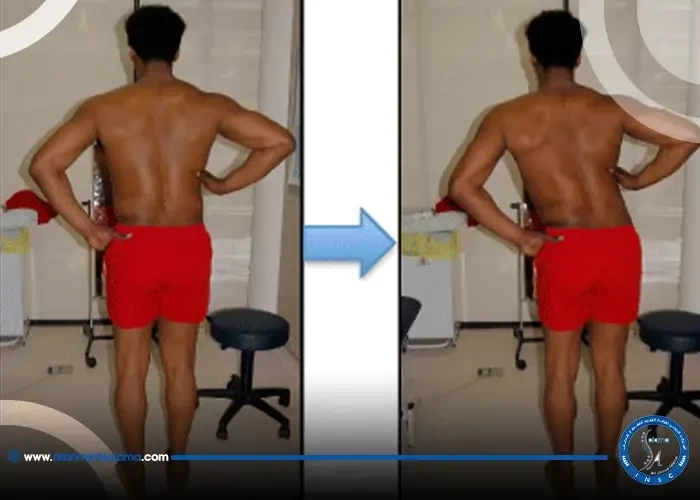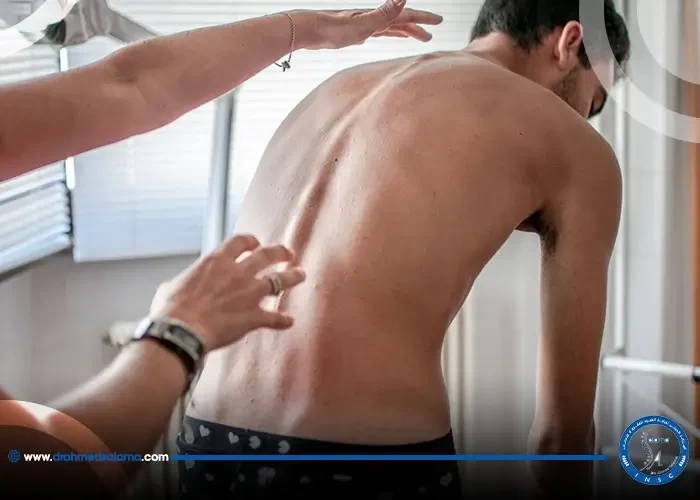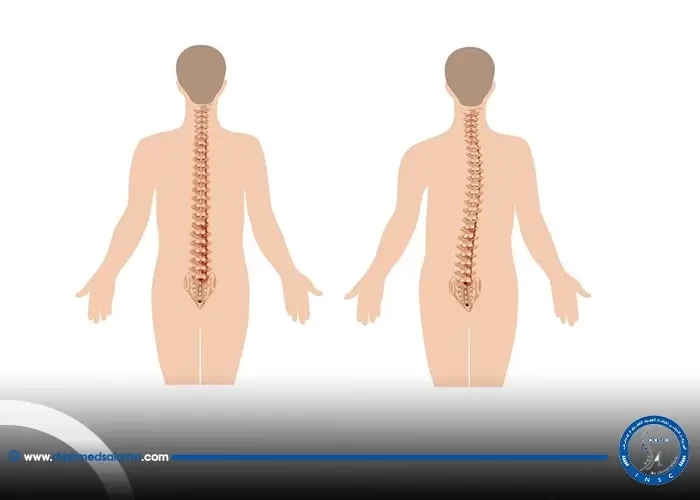Nasr City, 52 El Tayaran Street, in front of the Health Insurance Hospital

Herniated disc of the fifth sacral vertebra

L5-S1 disc herniation is a common condition that affects millions of people worldwide. It usually occurs in the lower back, causing intense pain and discomfort that can interfere with daily activities. This condition can be caused by a variety of factors, such as age, genetics, work-related activities, or trauma. However, it's important to understand the symptoms and treatments for this condition to ensure a full recovery. In this blog post, we'll explore everything you need to know about L5-S1 disc herniation. We'll describe its causes, signs and symptoms, diagnosis methods, treatment options and more. Whether you're experiencing back pain or just want to better understand this condition, keep reading to learn more about L5-S1 disc herniation!
Introduction to L5-S1 Disc Herniation
L5-S1 disc herniation is a common cause of low back pain that occurs when the disc between the last lumbar vertebra and the first sacral vertebra ruptures or bulges out of its normal position. As mentioned in the previous sections, this condition can cause symptoms such as sharp, burning, or stabbing pain that radiates into the buttock, lateral thigh, and leg. In this section, we will delve deeper into the introduction of L5-S1 disc herniation and its impact on individuals. Due to the location of L5-S1, this condition can be particularly debilitating and heavily restrict one's mobility. This is because L5-S1 marks the exact spot where the lumbar spine ends and the sacral spine begins. Understanding the cause, symptoms, and treatment options for this condition is crucial for effective management and prevention of future occurrences.
Causes and Symptoms of L5-S1 Disc Herniation
L5-S1 disc herniation is caused by excessive strain or injury, but it can also occur naturally as one ages. Repetitive activities that strain the spine and improper lifting can also provoke this condition. The symptoms include severe pain, weakness, numbness, and tingling in the groin and genital region, as well as buttocks, legs, and feet. In some cases, urinary retention causing incontinence, rectal dysfunction, and saddle anesthesia may be present. Patients may also experience back pain and radiculopathy, or numbness and tingling in the affected area. Physical therapy and surgery are among the treatment options for L5-S1 disc herniation. However, preventing this condition and adopting a healthy lifestyle may minimize the risk of developing it. Positive steps can include regular exercise, proper posture, regular stretching, and weight management which can reduce the chances of experiencing L5-S1 disc herniation.
Diagnosing L5-S1 Disc Herniation
To diagnose L5-S1 disc herniation, doctors start with a thorough physical exam to assess the patient's symptoms and pain level. They may also perform imaging tests such as an X-ray, MRI or CT scan to diagnose the condition. The most common levels for a herniated disc are L4-5 and L5-S1, with L5-S1 being the most common level. It is essential to identify the source of pain correctly and rule out any other underlying pathology, including spinal tumors or similar disorders. Once a diagnosis is confirmed, a treatment plan can be developed, which may include non-surgical or surgical options. Early detection and treatment, along with an effective recovery program, are crucial to successful management of L5-S1 disc herniation.
L5-S1 Disc Herniation Treatment Options
When it comes to treating L5-S1 disc herniation, there are various options available. Conservative treatments are often recommended initially and can include pain relievers, muscle relaxants, and physical therapy. Epidural steroid injections may also be used for symptom relief. In more severe cases, surgical intervention may be necessary, such as a microdiscectomy or fusion surgery. Recovery and rehabilitation from any treatment option may involve physical therapy and personalized exercises to help improve flexibility and strength in the affected area. Preventative measures, such as maintaining good posture and avoiding heavy lifting, can also help reduce the risk of further injury. Consulting with experts in the field can provide valuable insights and guidance on managing L5-S1 disc herniation.
Physical Therapy for L5-S1 Disc Herniation
Physical therapy is a crucial component in the treatment of L5-S1 disc herniation. While other treatments like medication and injections may provide temporary relief, physical therapy aims to address the root cause of the problem. Through various exercises and techniques, physical therapy helps to alleviate pain, increase flexibility, and strengthen muscles surrounding the affected disc. Aerobic exercises like walking, biking or swimming can increase blood flow to the area, while strengthening exercises improve posture and stability. A chiropractor may also prescribe yoga or cat-cow exercises to help alleviate pain. Physical therapy outcomes differ for each individual, but it is a key component in most L5-S1 disc herniation treatment plans. With expert advice and guidance, patients can manage L5-S1 disc herniation and work towards a pain-free life.
Surgery for L5-S1 Disc Herniation
When physical therapy and other non-surgical treatments fail to alleviate symptoms, surgery may become necessary to treat L5-S1 disc herniation. Traditional open discectomy, while effective, can be invasive and has the potential to cause further trauma to the spine. However, more modern techniques such as endoscopic surgery and transforaminal endoscopic lumbar discectomy (TELD) offer less invasive options with fewer complications. The Deuk Laser Disc Repair, a revolutionary new surgical procedure using laser technology, has also shown promising results. Recovery from surgery will depend on the technique used, but physical therapy and rehabilitation are typically necessary to restore strength and mobility to the affected area. It's important to remember that surgery is not always necessary for L5-S1 disc herniation and should only be considered after exhausting non-surgical options and consulting with a doctor. Proper post-surgery care and lifestyle changes can help prevent future herniation and promote overall spinal health.
Recovery and Rehabilitation from L5-S1 Disc Herniation
After undergoing treatment for L5-S1 disc herniation, recovery and rehabilitation are vital. The first two weeks of recovery are often the most challenging, with significant discomfort being the norm. However, one should still strive to stay active while allowing time for the body to heal. Physical therapy is a common rehabilitation option, with exercises and stretches that can help to strengthen the spine and prevent future occurrences. In some cases, surgery may be required, and a rehabilitation program will be necessary after the procedure to ensure a smooth recovery. Lifestyle changes and expert advice on managing L5-S1 disc herniation can also provide long-term benefits. With proper care and attention, recovery and rehabilitation from L5-S1 disc herniation can lead to improved overall health and wellness.
Preventing L5-S1 Disc Herniation
While some risk factors for L5-S1 disc herniation are beyond our control, there are steps we can take to prevent it. One of the most important ways to prevent L5-S1 disc herniation is to maintain a healthy weight, as excess weight puts added pressure on the lower back. Regular exercise is also important, but it's important to choose activities that don't strain the L5-S1 region. Good posture, both when sitting and standing, can help prevent unnecessary stress on the lower back. Additionally, lifting heavy objects properly (with a straight back and using your legs to lift) can prevent traumatic injuries.
It's important to be mindful of repetitive movements that can strain the lower back over time, such as long periods of sitting, bending, or twisting. Taking frequent breaks to stretch or change positions can help prevent L5-S1 disc herniation. Lastly, it's important to address any underlying medical conditions that can contribute to disc degeneration, such as osteoporosis or arthritis.
By implementing these preventative measures, individuals can significantly reduce their risk of L5-S1 disc herniation and maintain a healthy, pain-free back. However, if symptoms do arise, it's essential to seek medical attention to ensure proper diagnosis and treatment.
Lifestyle Changes for L5-S1 Disc Herniation
Making lifestyle changes is crucial for managing L5-S1 disc herniation. Patients with this condition need to maintain a healthy weight to relieve pressure on the affected discs. Moreover, practicing good posture and body mechanics, such as bending at the knees instead of the waist, can prevent further injury. Additionally, regular exercise and physical therapy can strengthen the back muscles, improve flexibility, and decrease pain. Patients also need to avoid activities that exacerbate their symptoms, such as heavy lifting or prolonged sitting. Overall, by incorporating these lifestyle changes into their daily routine, patients with L5-S1 disc herniation can effectively manage their condition and reduce the likelihood of future episodes.
Expert Advice on Managing L5-S1 Disc Herniation.
Section 10 of the blog on L5-S1 disc herniation provides expert advice on managing this common condition. It is crucial to listen to your doctor's recommendations and follow the prescribed treatment plan. Exercise and physical therapy are beneficial in managing symptoms and improving mobility. It's important to know your limitations and avoid activities that may exacerbate the condition. In some cases, surgery may be necessary if conservative treatments are ineffective. The recovery and rehabilitation process is unique to each individual, but with proper care, most people can resume their normal activities. Preventing L5-S1 disc herniation involves maintaining a healthy weight, regular exercise, and avoiding activities that may strain the spine. Expert advice is available to address any concerns and help you manage L5-S1 disc herniation effectively.
Can a herniated disc occur in the sacral vertebrae?
Yes, a herniated disc in the sacral vertebrae can occur, but the incidence is small. This can be avoided by avoiding sudden heavy lifting and exercising regularly.
What is the treatment for a slipped fifth vertebra?
A slipped fifth vertebra can be treated with medication, physical therapy, traditional or endoscopic surgery. The type of treatment varies depending on the patient's degree of slippage






